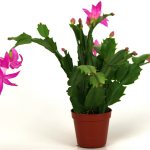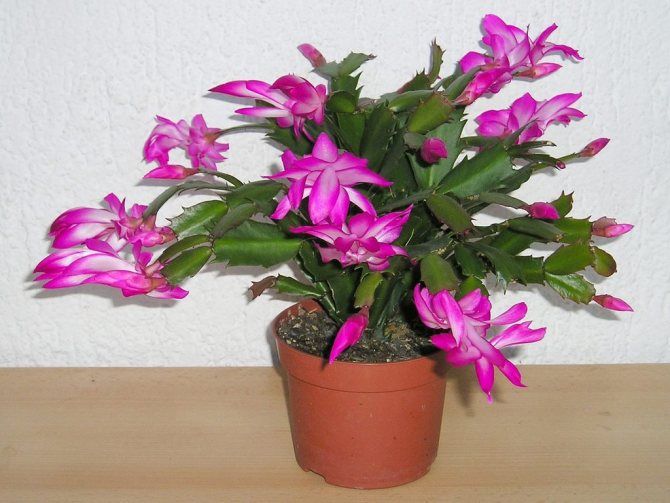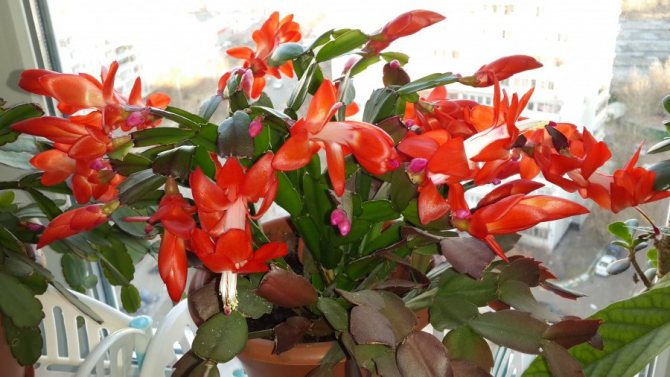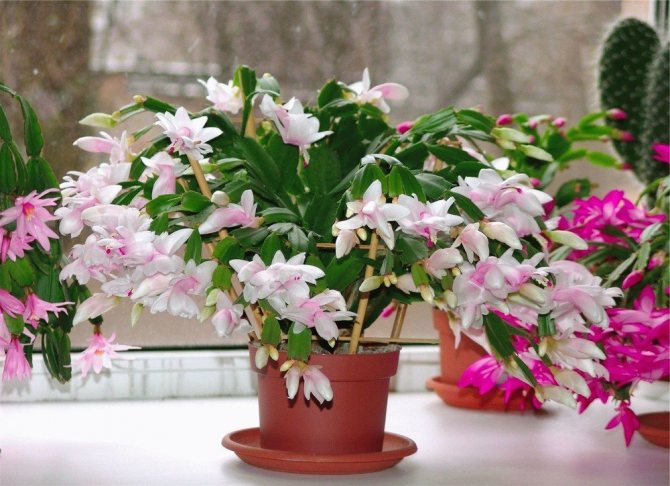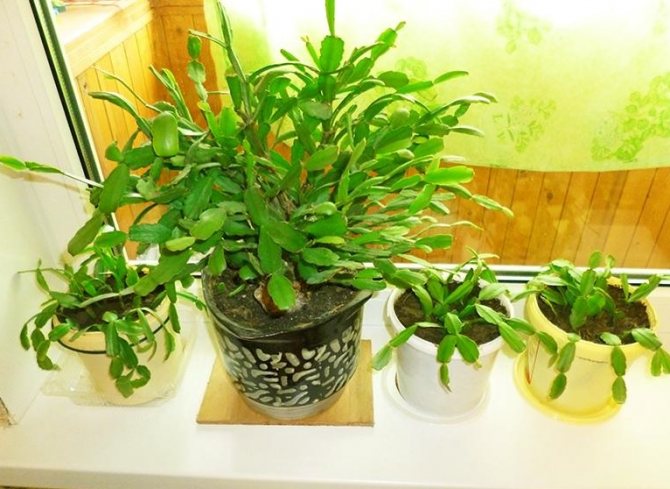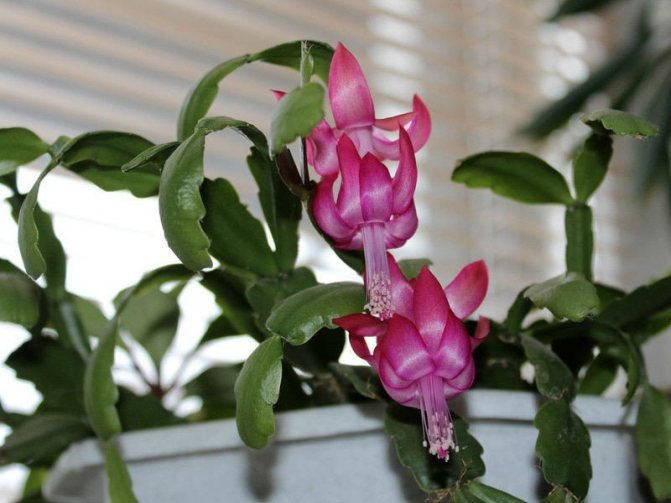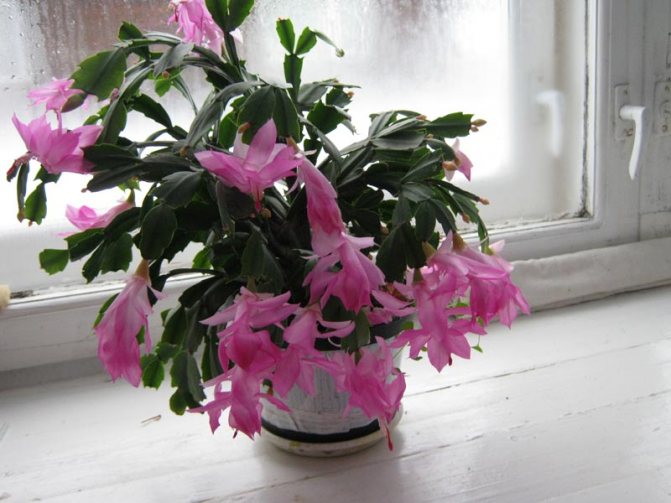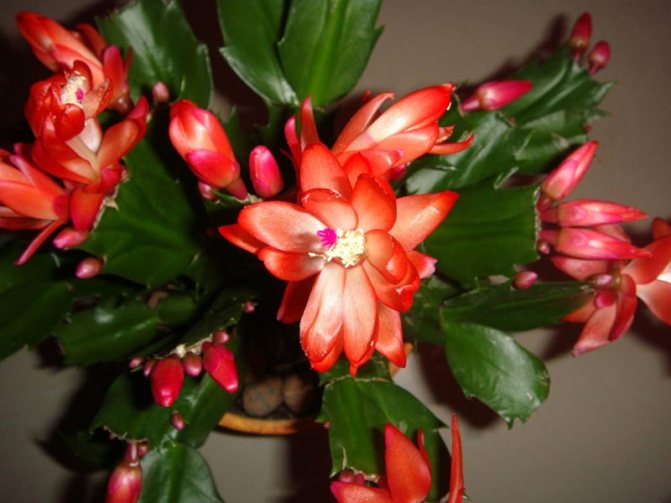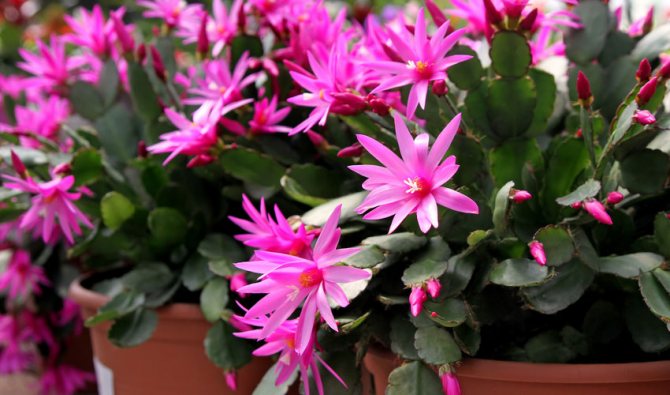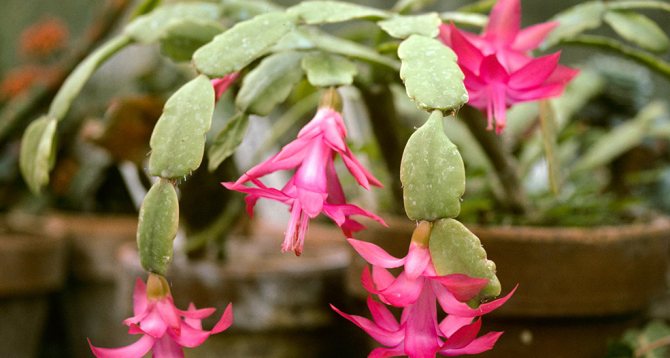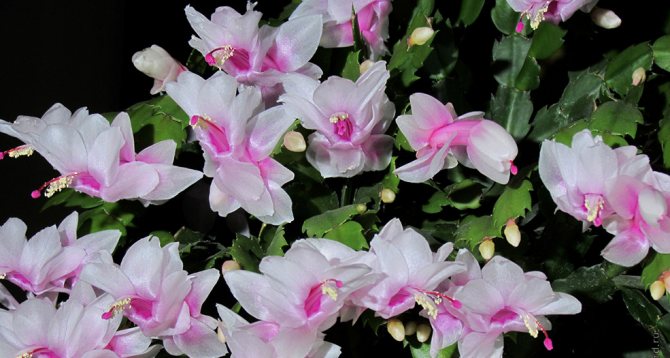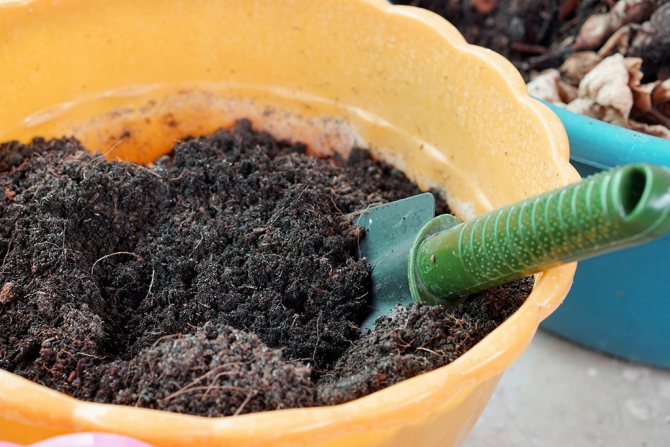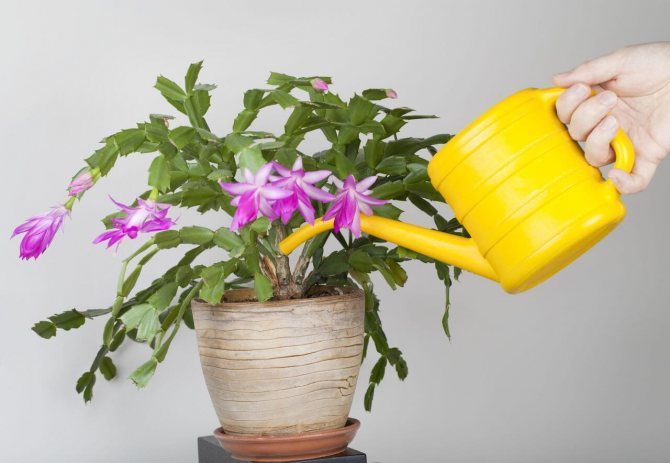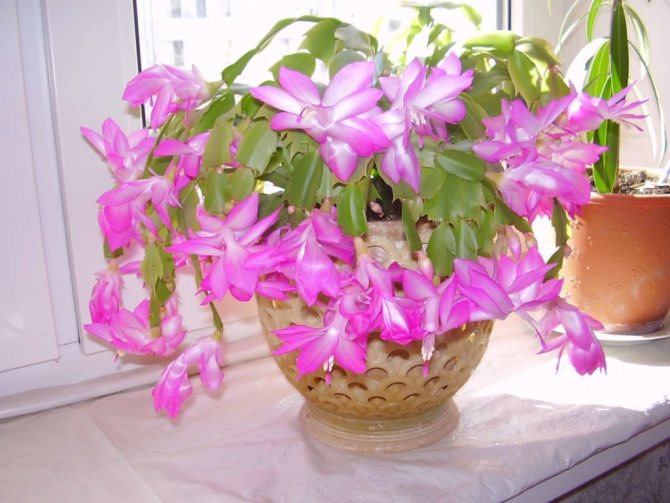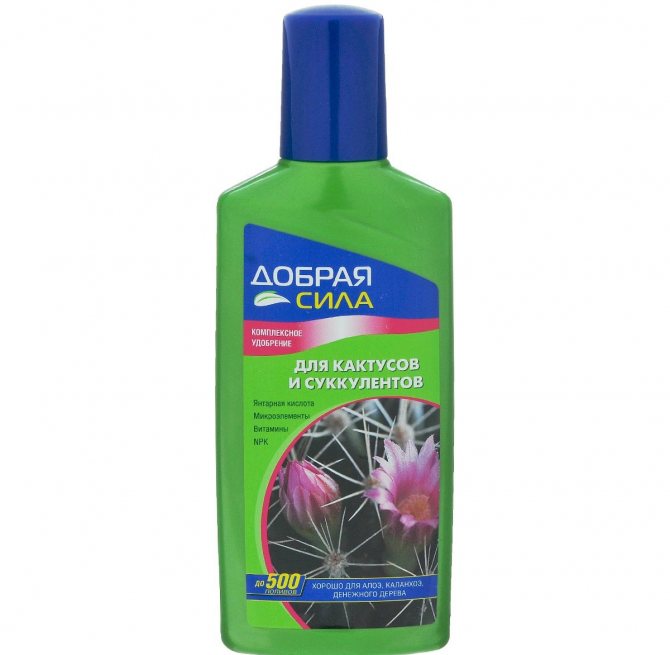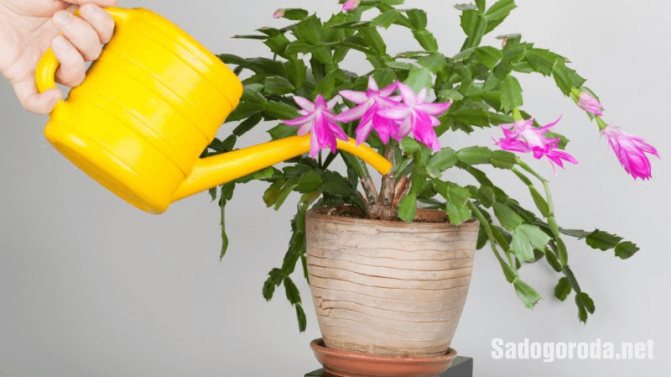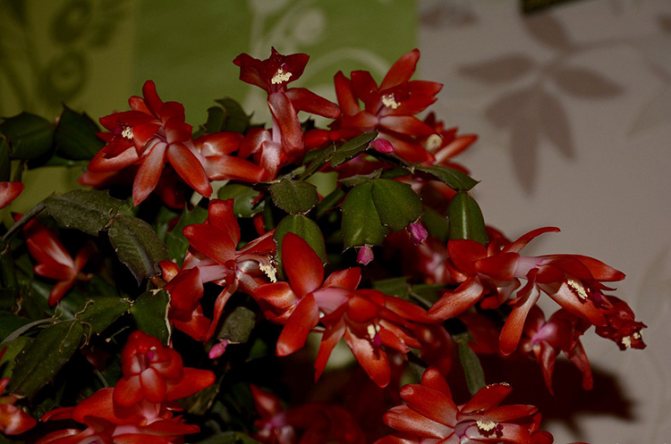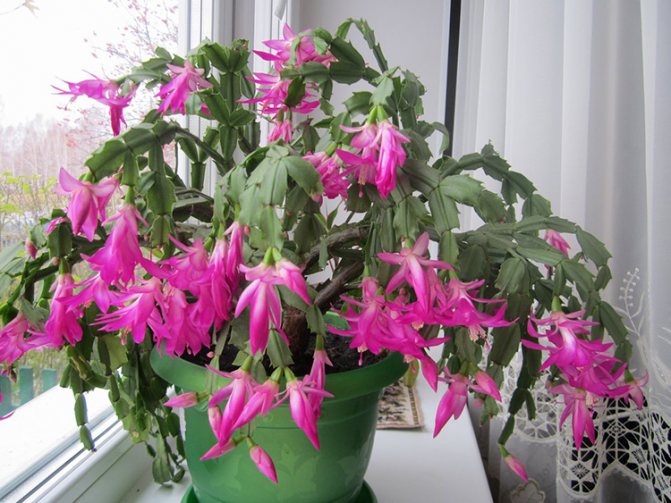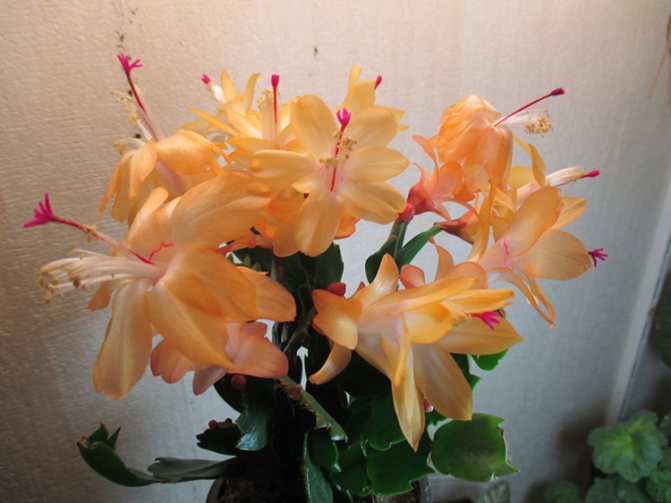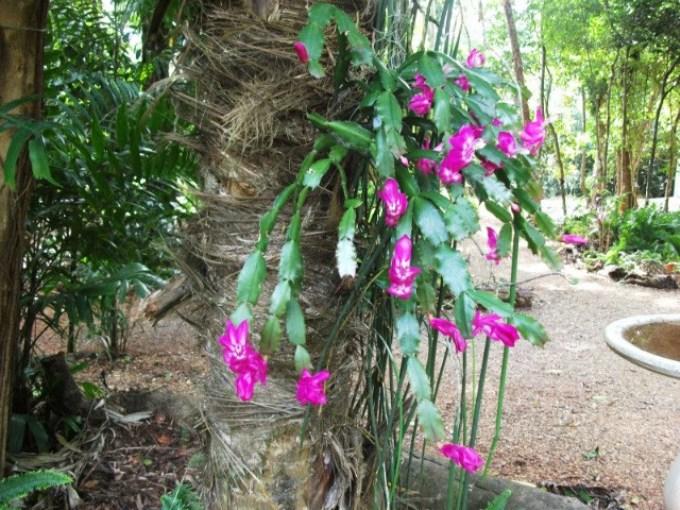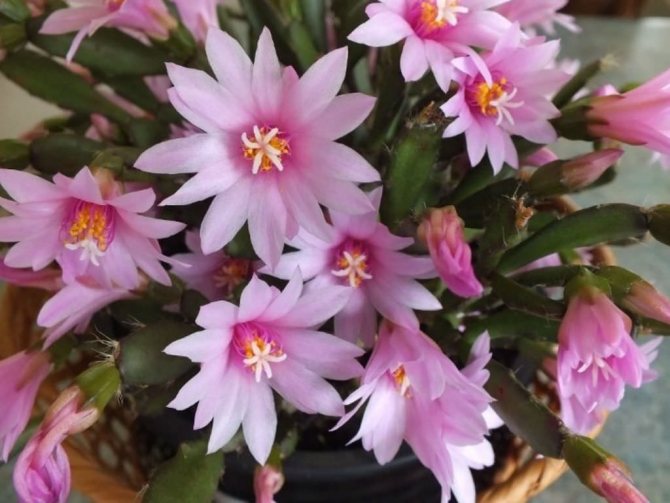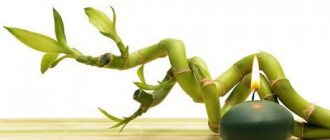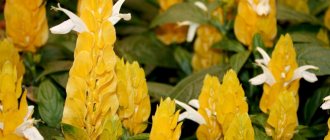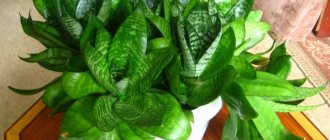12/30/2018 Irina Malinina 1 Comment
Many novice gardeners are convinced that a cactus is necessarily a thorny "pet" that loves the sun and is afraid of excess moisture. But a beautiful Decembrist flower is able to destroy these prevailing ideas and prejudices.
Where did this strange name come from? How difficult is it to bloom? What should be the care of a popular plant? What superstitions accompany its cultivation? Our article will tell about all this and much more.
Location and lighting
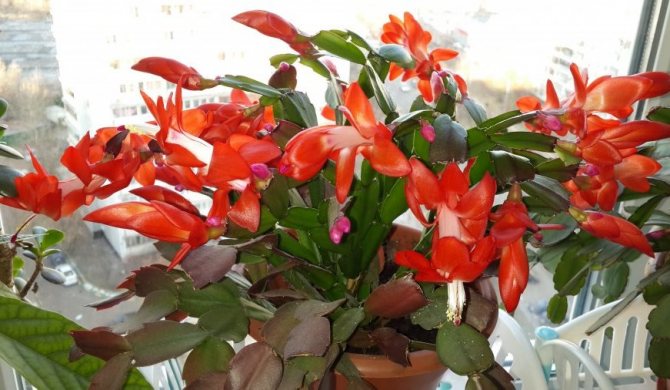
Our article Decembrist (Schlumberger) - description, types and varieties will help you choose the right type of Schlumberger.
It is better to place the pot with the Decembrist in partial shade. The flower loves good lighting, but does not tolerate the bright direct sun, from which its stems can get burned, and the final leaf segments can dry out and die off. Therefore, window sills of the southern and western directions will not work. Better if these are east windows. If you have an ampelous view of Zygocactus, then instead of a pot, you can grow a flower in a hanging planter near the windows. In the summer, we recommend taking the flower out to the balcony or loggia and placing it or hanging it there in partial shade. You can find a well-lit place for him, but protected from direct rays of the sun and wind, in your garden or in the country.
In addition, for the formation of a bush harmoniously developed on all sides, the pot must be turned towards the light in different directions. This can be done all summer, until the beginning of autumn, while the Decembrist is actively building up shoots. If the bush stays with one side to the light all summer long, then by the time of flowering it will be one-sided. But during this period, it is too late to deal with the correction of the appearance of the cactus - neither unscrew the extra shoots, nor turn the pot with its other side to the light during flowering.
With the onset of cool nights, the Decembrist should be brought into the room. In winter, during a set of buds and flowering, it is advisable to organize additional lighting for the flower with a fluorescent lamp or phytolamp.
Plant species
Several species of Schlumberger have been found in total. But there are very, very many hybrids and plant varieties. And this list is constantly growing due to the appearance of new copies. But we will list only the most basic varieties of the Decembrist.
- Schlumbergera truncatus (truncated). The growth of an adult plant reaches half a meter. The stems are long (up to 300 mm), consisting of several segments with pronounced teeth. The flowering plant is completely covered with clusters of flowers of white, pinkish, lilac or violet color. In their place, small fruits of a bright red hue are subsequently formed.
- Schlumbergera bucklei (booklei). This zygocactus is less tall than the previous Decembrist species. Branched stems, dark green, shiny. There are no thorns, instead of them there is a light edge. The flowers are large - up to 80 mm, in different shades. You can buy yellow varieties of this variety of Christmas tree.
- Schlumbergera Russelliana (Russeliana). Small cactus up to 300 mm in height. Stems well developed, without thorns, divided into flattened shiny segments.The plant is grown in hanging pots, since the shoots can reach a length of 100 cm. The flowers are large, their color can be reddish, pinkish, carmine or purple.
- Schlumbergera gaertneri (Gertner). This zygocactus is quite large. The segments of the stem alone can reach 60-70 mm in length. The main feature of this type of Decembrist is the huge buds that resemble bells with pointed petals. The color of the flowers is bright red with an orange tint.
- Schlumbergera opuntioides (opuntia). As the name suggests, the plant is very similar to the prickly pear, that is, the cactus. Stem segments are very fleshy, covered with thorns. During the flowering period (in early spring), this Decembrist variety is also covered with pink-purple buds.
If you want to please yourself with more daring and unusual Schlumberger varieties, then start growing hybrid varieties. The most popular are Madonna Danse, Madame Butterfly, Pasadena, Golden Cream. The beauty of their flowers will amaze all plant lovers.
Watering
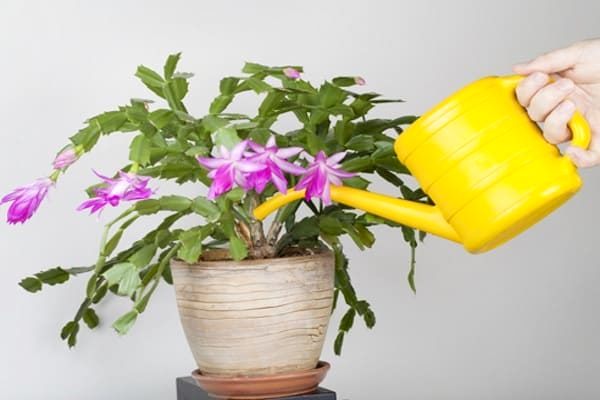

It is necessary to designate several different periods in the life of the Decembrist, when the irrigation regime should be changed. The common thing is that Schlumberger should be watered with warm, settled water, preferably boiled. The substrate should dry well between waterings. Cold hard water and abundant watering, after which the earth does not have time to dry out, can cause rotting of the roots and disease of the plant with fungal infections.
Now about the features. During a set of buds and flowering, from November to February, the Decembrist should be watered with such regularity so that the soil is constantly moist. After flowering, from February to March, the next watering is carried out after the top layer of the substrate dries well to a depth of 2 cm. It is impossible to dry out the soil at all. Observe the same watering regime during the dormant period of the Decembrist before flowering (September-November). In the summer, watering should be regular and moderate, two to three times a week. Make sure that the soil dries out almost completely between waterings.
Schlumberger whisk shading
The Decembrist, as a representative of the bright Brazilian flora, stands out for the variety of color and intensity of the color scheme of its buds. The flowers of natural species found in indoor culture have a rich red tint.
Specimens of Schlumberger varieties shine with tints of pink, red and cream color scheme. Among the variety of varieties, you can find the white Decembrist, as well as plants with yellowish and two-colored buds. As an exception, there are Decembrists with orange and even purple tints of corollas.
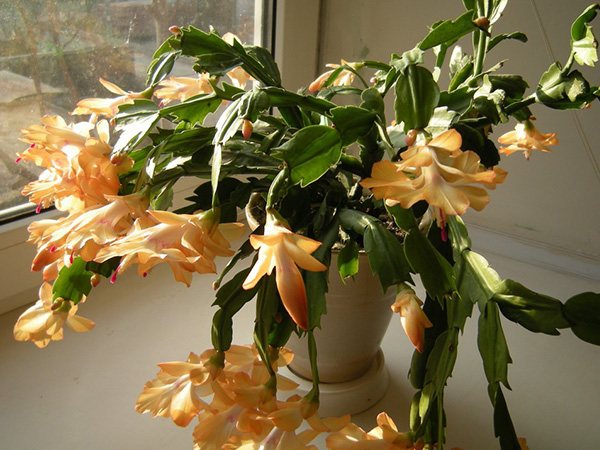

Temperature
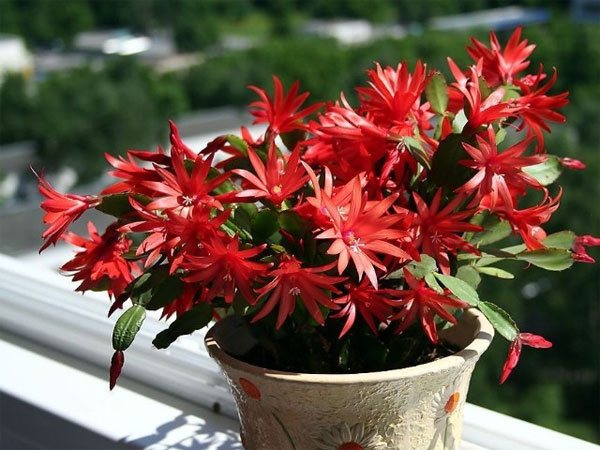

The Decembrist normally refers to the usual room temperature of the content - from 18 to 26 grams. Celsius. When the room is too hot, spray it more often and monitor the humidity readings - this cactus was born in the tropics. During its rest before flowering (September - November) and after flowering (February - March), it is advisable to reduce the temperature of the content to 12 - 16 grams. During a set of buds and flowering (November - February), do not allow drafts and sudden temperature changes. It is good if it is constantly in the range of 16 - 18 grams. Then the Decembrist will bloom longer and more abundantly.
Temperatures above 37 and below 2 degrees Celsius are considered critical for Zygocactus.
Popular types and varieties of Zygokactus
In indoor culture, according to the GRIN - Genetic Resources Information Network, flower growers breed 9 main species of Schlumberger. These species are basic for the selection work of cactus growers in all countries of the world, on their basis a large number of varieties and hybrids of Zygocactus. Research specialists are constantly being conducted, thanks to which new varieties of this popular plant continue to be registered every year.
Photos help to reveal some of the features of the main varieties of the Decembrist.
Buckley
The most common Decembrist variety, characterized by increased ability to adapt to regimes leaving and particularly resistant to diseases and pests. Can be grown as an ampelous plant.
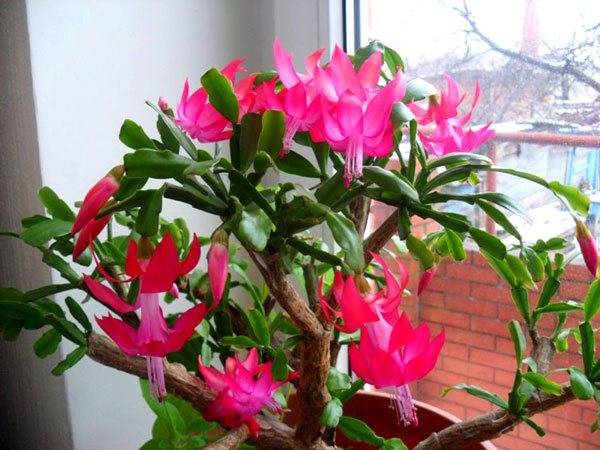

The cactus grows up to half a meter in height, has soft segments of stems of a dark shade of greenery, which coarsen at the base as the plant matures. The flowers are large, tubular, colored in different tones of pink and lilac tones.
Schlumberger Buckley is distinguished by long flowering: from late autumn to March.
Schlumberger's truncated
This variety is one of the basic varieties for breeding. Plant height does not exceed 0.5 m. Both erect and ampelous forms are cultivated.
Dekabrina is characterized by small light segments jagged along the contour. The flowers are large, with curved petals, painted in various shades of crimson, less often in other tones.


Kautsky
The Decembrist variety, resembling Sh. Truncated - at one time these varieties were considered related subspecies. But due to the smaller dimensions, the Decembrist Kautsky was transferred to the category of an independent type.


Differs in purple tones of buds.
Microcylindrical
This succulent is distinguished by the cylindrical shape of all segments. The color of the buds ranges from white to lilac shades.
The plant begins to bloom in March.
Russeliana
A low variety of Decembrist (about 30 cm), which is capable of growing long, almost one meter long, creeping stems. Differs in increased stability to unfavorable conditions.


The plant blooms from February to April, forming many pink buds.
Orsiciana
Feature - the color of the corolla petals with a noticeable color transition from reddish around the edges to white-pink in the center.
Able to form buds 3 times a year: March - August - November.
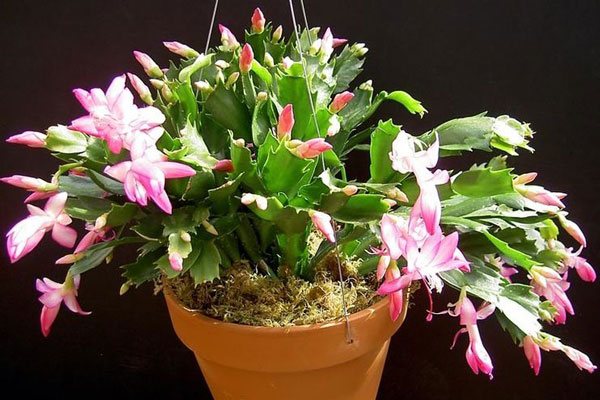

Opuntia
Succulent is a rare variety in collections. A characteristic feature is the presence of white areolas with long spines, due to which the segments Decembrist are similar to the stems of Opuntia.
The stems can reach over a meter in length. It blooms in the spring with large corollas of pink-purple hues.
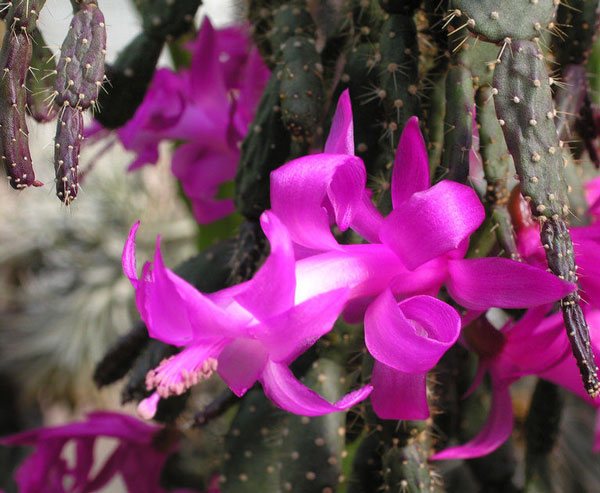

Distinctive features of the Decembrist varieties and hybrids can be seen in the photos below.
Christmas fantasy
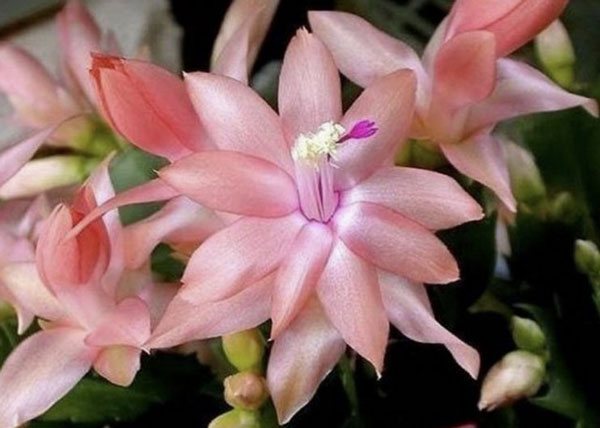

Gertner
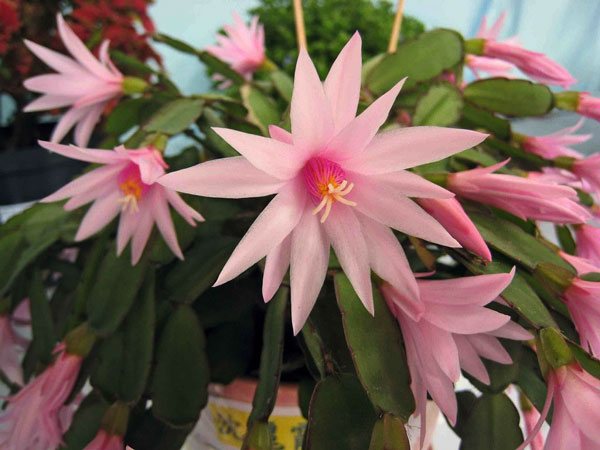

Pasadena
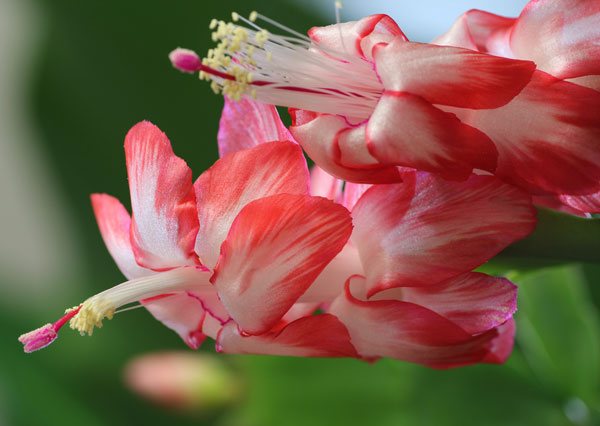

Golden cream
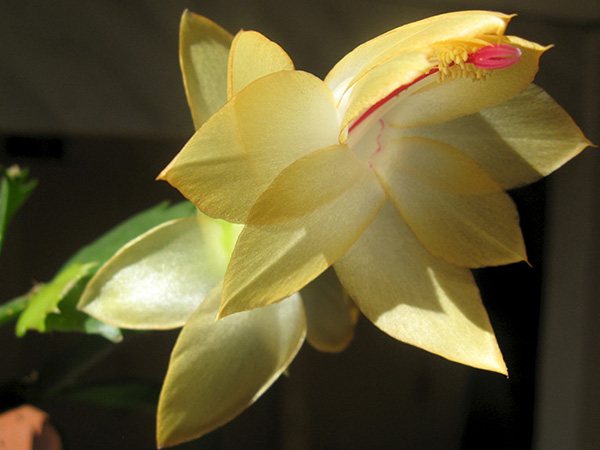

Lavender doll
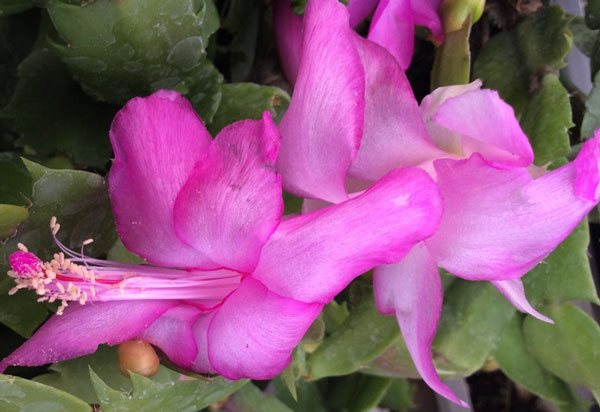

Aspen


Windsor
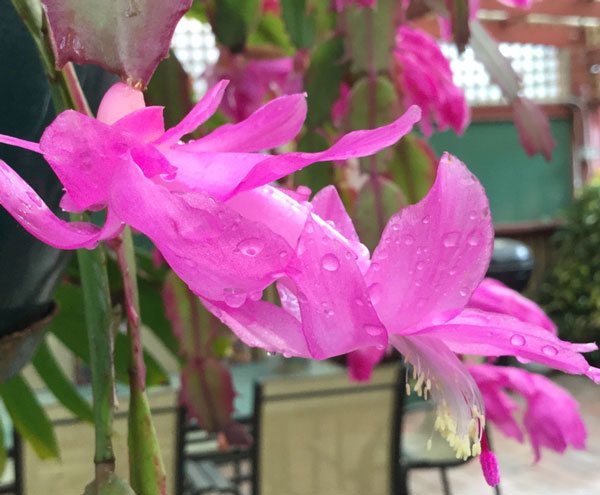

Mix
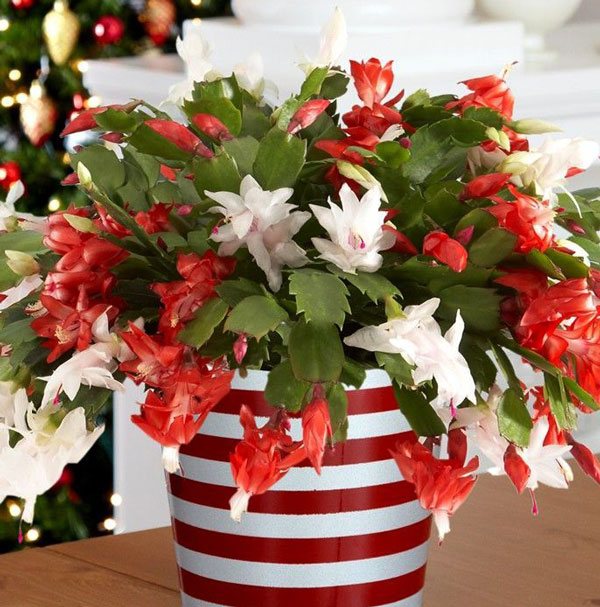

Lavender fantasy
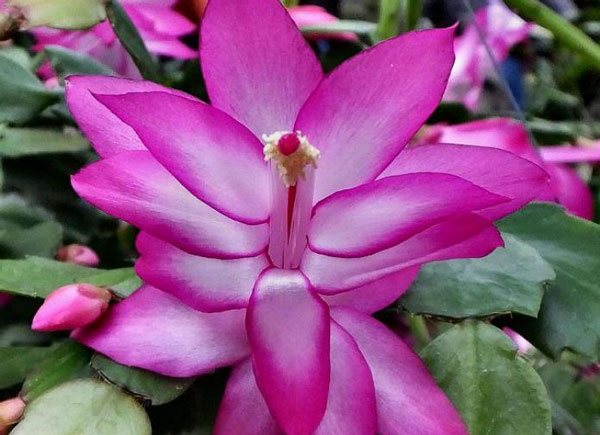

Christmas flame
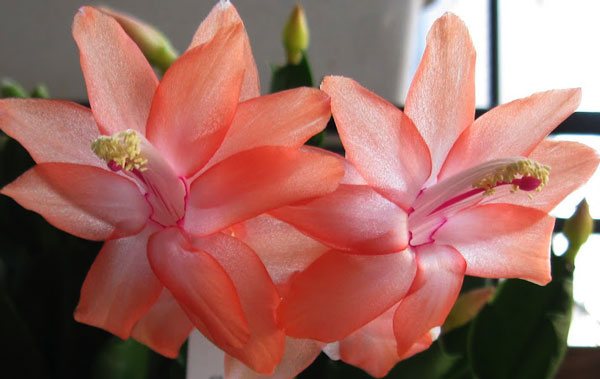

Sanibel
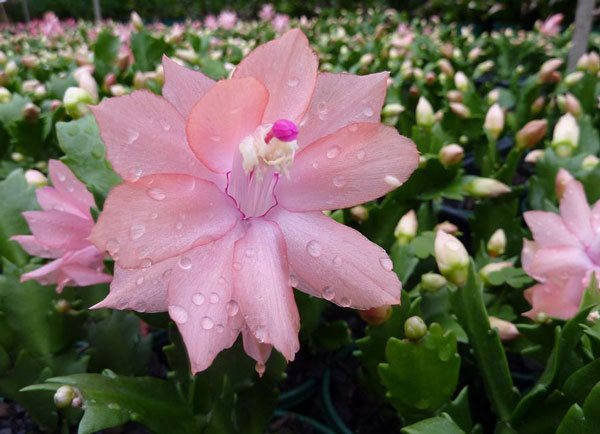

Chris Kringle
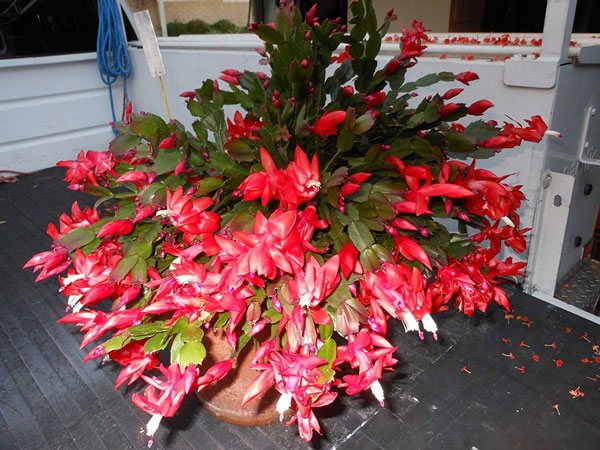

Malissa
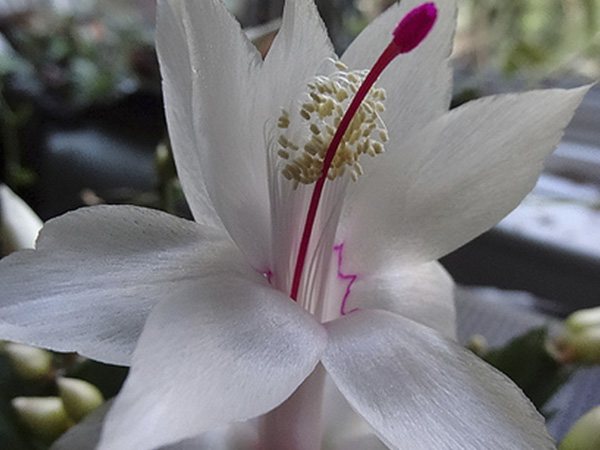

Santa cruz
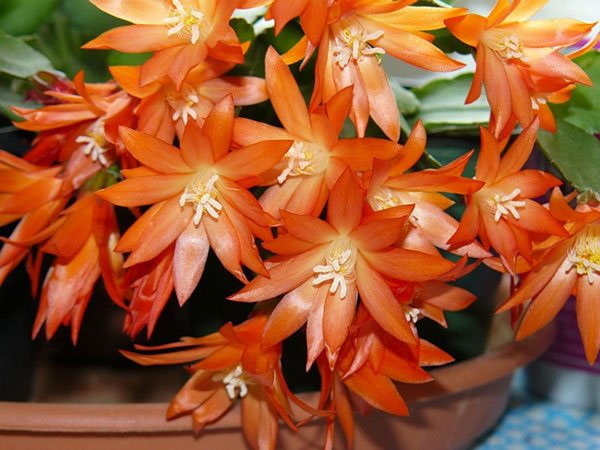

Christmas mood
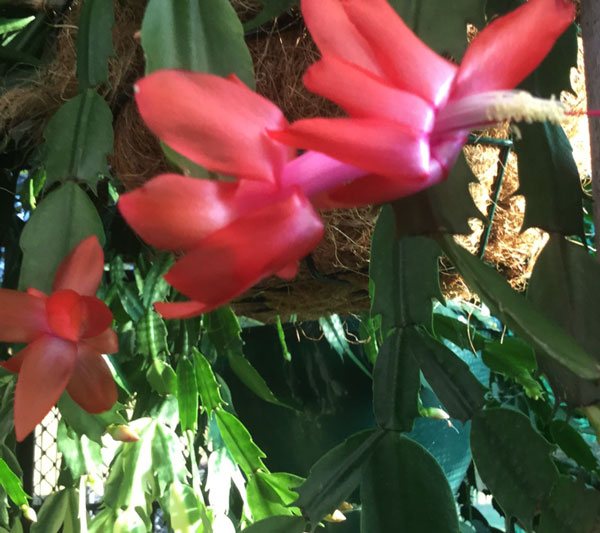

Twilight tangerine
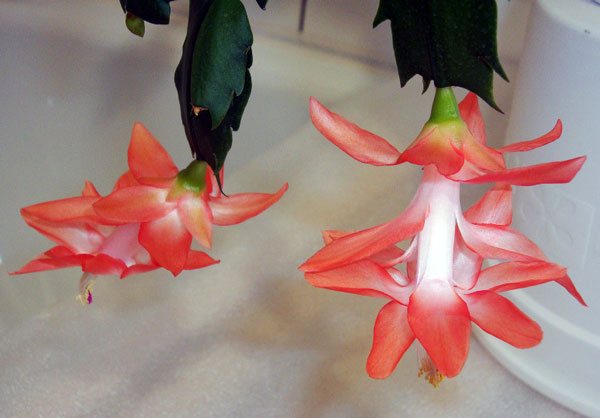

Cambridge
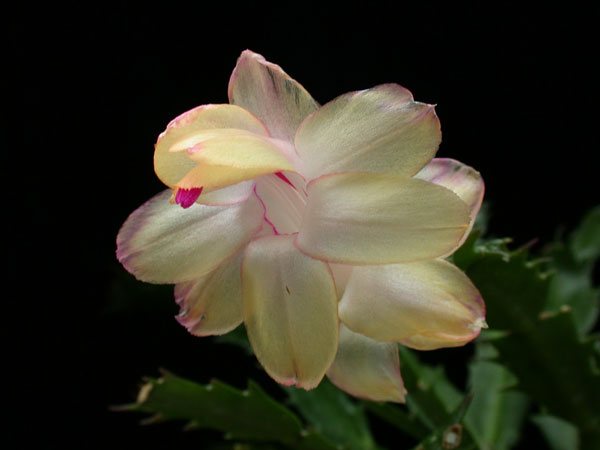

Bridgeport
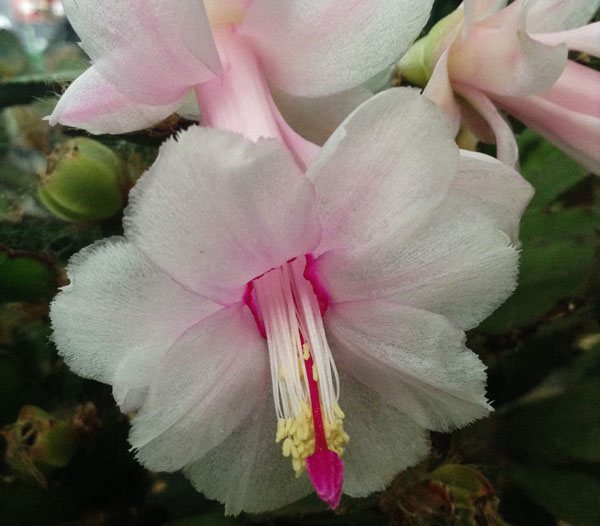

Golden fever
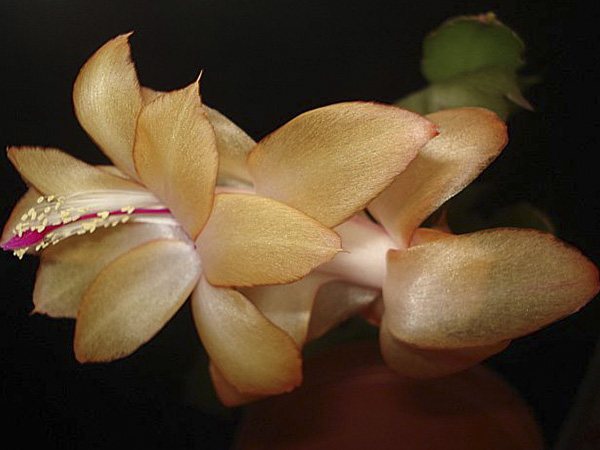

Peach parfait


Dark Eve
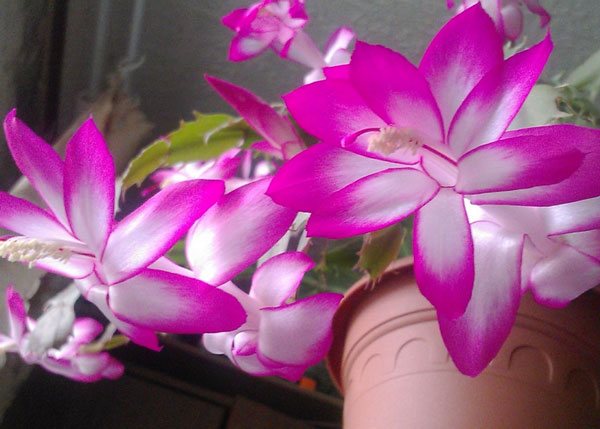

Madame Butterfly
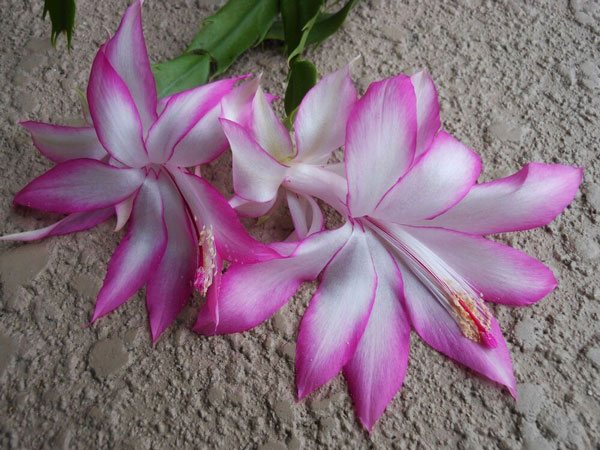

White christmas


Soil and pot
The soil for Schlumberger is slightly acidic, loose and light. Ready-made substrate for succulents or cacti can be purchased at the store. Preparing the soil on your own is also not difficult. Recall that in nature, these cacti grow on trees where there is no soil, in the usual sense of the word. Mix peat, leafy and turf soil with coarse sand in equal proportions. For disinfection, add a little crushed coal, and for good water permeability, add vermiculite or brick chips.


Choose a container for planting not deep, since the root system of the Decembrist is shallow, and not too wide, since the Decembrist blooms more readily in a narrow pot. One third of the pot should be occupied by a drainage layer. In the bottom there are drainage holes, under the pot there is a pallet. A ceramic pot will be preferred over others. For transplanting, each time select a container two to three cm wider than the previous one.
Flower Decembrist - description of the plant
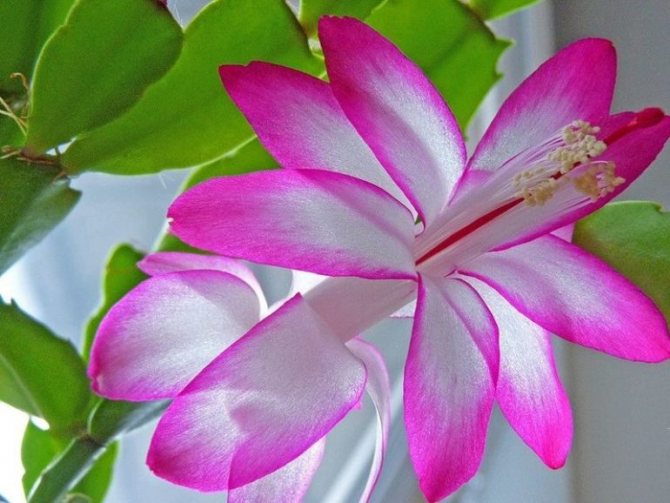

The generally recognized name for the flower is zygocactus. There is also another botanical name - Schlumberger. It was awarded in honor of the scientist from France Frederic Schlumberger, who was the discoverer of this variety of cacti.
In Russia, the plant is called the Decembrist or Christmas tree because of its peculiarity to release bright inflorescences in winter frosts. December and January blooms are associated with the fact that in nature, zygocactus blooms in the middle of summer, which in South American latitudes coincides with the Russian winter.
At first, Schlumberger had exclusively red flowers. However, after breeding work, florists were able to grow plants with pinkish, white, lilac, yellow bunches. More recently, a Decembrist variety has appeared on the market, on which flowers of different colors coexist.
This beautiful tropical South American plant belongs to the epiphytic cacti. In natural nature, it grows on the root formations or trunks of Brazilian trees, forming real armfuls of flowers on hanging stems.
In general, the natural conditions for the growth of the Decembrist are as follows.
- Cacti are constantly in a semi-shaded environment (due to the fact that they grow under the crown of trees). Naturally, this cannot but affect their cautious attitude towards direct sunlight.
- Schlumberger's are located on branches or roots, therefore, the requirements for the soil composition are minimal. A plant does not need a rich complex of various micro- and macroelements and other useful substances.
- Since zygocactus grows in the humid climate of tropical forests, it is necessary to provide appropriate conditions in the room where the container with the plant will stand.
As can be understood from the above, the Decembrist is significantly different from the "classic" cacti. Accordingly, it is necessary to provide favorable plant care, taking into account certain conditions and requirements. If everything is done correctly, then a tropical guest will delight you with flowering for more than a dozen years.
Top dressing
The Decembrist needs feeding. Complex fertilizers are suitable for epiphytic plants. If you don't find such, buy ordinary liquid complex fertilizers for decorative leafy indoor flowers. Only use a dose half the amount recommended on the package. In the spring, it is enough to feed once a month. In the summer, when the stems begin to actively grow, feed the plant more often, twice a month. Stop feeding in the fall to allow the plant to rest before budding. At the same time, it is desirable, in order to prevent fungal diseases, to treat the Decembrist with some kind of fungicide.
Landing
Landing recommendations:
- The pot should be slightly larger than the root system of the flower;
- Pour a layer of expanded clay on the bottom;
- Then we put a 3-5 cm layer of nutritious soil;
- On this layer we put the root system of the flower and spread the roots in different directions;
- We fill up the empty space with prepared earth
- Slightly squeeze the ground around the bush to get rid of voids in the ground;
- The growth point should be at the same level as before the transplant.
Important! You need to follow the sequence of recommendations and be careful with the first watering, not doing it immediately after planting.
Conditions for the annual flowering of the Decembrist
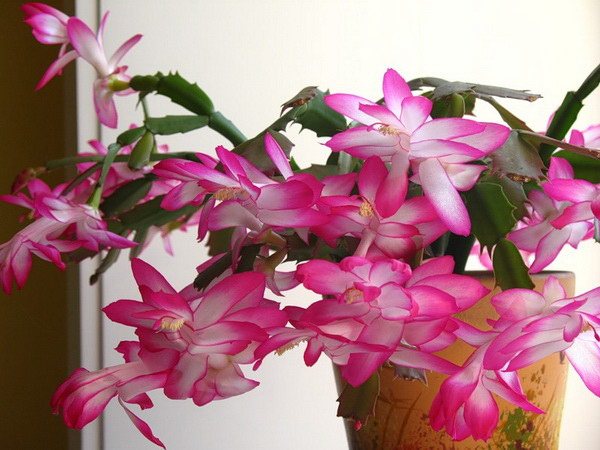

Many people wonder why the Christmas tree does not bloom? The fact is that in order to make the Zygokaktus Decembrist bloom in December, from the beginning of September it is necessary to prepare it for this. Reduce watering the flower, stop feeding it, move it to a cooler but not dark room. There, at a temperature of 12 - 16 degrees. Celsius, it should be at rest for about three months.


At the end of November, return the flower to its original place - light and warm. Start watering regularly - the Decembrist should wake up and feel that it is time for him to bloom.At this time, you need to rotate the plant around its axis for uniform illumination of its shoots from all sides. Watch the cactus.
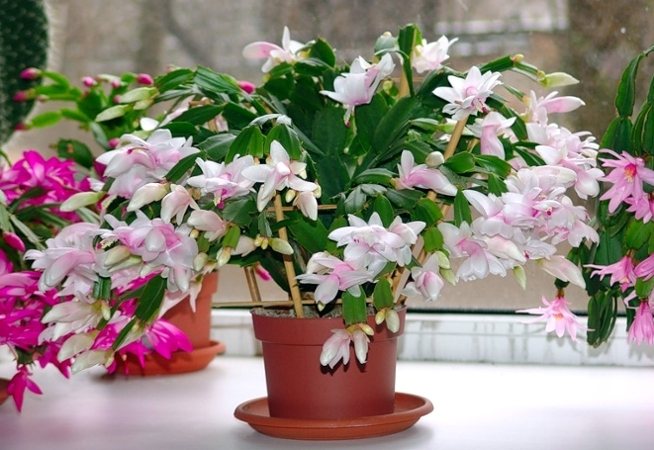

As soon as you see that buds have begun to form at the ends of its leaf-segments, stop disturbing the flower: do not move it to other places anymore, do not turn it in different directions, especially do not transplant it into another pot - it can panic and throw off the long-awaited buds. Warn your family about this. And also, make sure that the substrate in the pot is always slightly damp.
No less important are all the previously described rules for keeping a flower. If you have followed these rules all year, your Decembrist will definitely bloom.
For flowering to last longer, remove faded buds in a timely manner. Watch the temperature - it should be in the range of 16 - 20 grams. and no sudden changes. Watering should be regular and abundant with soft boiled water at room temperature.
This might be interesting: Poinsettia is a Christmas star


After the Decembrist has bloomed, begin to gradually reduce watering. Transfer the flower pot again to a cool place with a temperature of about 15 grams. Do not feed, let the flower rest and gain new strength. The vegetative period for Rozhdestvennik begins at the end of March. At this time, return the flower to its former light and warm place. Start a new season with more watering and feeding.
What to do if the Decembrist does not bloom


So, we figured out when the Decembrist blooms. However, some florists never wait for the coveted inflorescences in the winter months. Why is this happening and how can you help a Christmas tree get bright and attractive bunches of flowers?
Among the reasons for the lack of flowers, experts distinguish low-quality (not meeting the requirements of the plant) soil, low air humidity, excessive shading, and lack of nutrients. All these factors need to be analyzed and eliminated.
Another question is how to "force" the Schlumberger to bloom at home?
You need to prepare in advance and follow these steps:
- choose not too wide planting capacity (so that the flower is cramped);
- do not put the pot in a too warm place - the optimum temperature is +16 degrees (in a cool microclimate, flowering will be longer);
- exclude serious temperature drops;
- put the pot with zygocactus in one place and refuse to move and turn it over (otherwise the buds will fall off);
- carry out pruning (pinching) in advance and do not pick off the stems in October-November, otherwise you may not wait for the buds at all;
- organize additional lighting in the room if there is a lack of sunlight in the autumn-winter period (you can put the pot next to the lighting fixture);
- abandon top dressing in September, because otherwise the plant will form stems, not buds;
- reduce the intensity of watering during the formation of buds (October-November), but when the plant blooms, the volume of water can be slightly increased, but very carefully.
All these recommendations will allow you to finish off the abundant flowering of the Decembrist. And, of course, it is necessary to follow the principles of care described above so that the zygocactus feels great not only during budding, but also throughout the year.
Reproduction of Schlumberger cuttings
The Decembrist reproduces very easily by cuttings. Unscrew a stalk with two to three extreme leaf segments from the mother plant. Dry them for a day - two on a plate in the shade and then plant them in a moist substrate of peat and sand. To accelerate root formation, you can use special preparations: zircon or root. Cover the shank container with something suitable for a greenhouse effect. Maintain the temperature at about 20 grams. Celsius. Find a place in your greenhouse in partial shade.Open and ventilate once a day. The Decembrist successfully takes root in the spring and summer for a month.
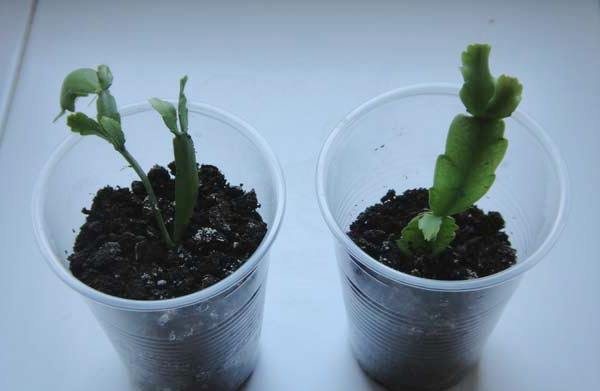

Decembrist cuttings in cups
Specialists are usually engaged in rooting those cuttings that were obtained during the pruning of the Decembrist.
Note that cuttings root in a glass of water in the same way. After a new segment appears on the cutting, rooting can be considered successful. The bush is ready for transplanting into a pot with suitable soil according to all the rules.
Caring for the Decembrist after purchase
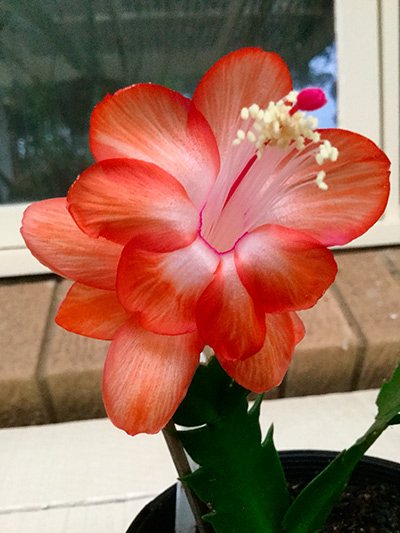

First of all, you need to make sure that the flower is healthy. To do this, it is quarantined for 2 weeks separately from other plants.
During this time, he also undergoes acclimatization in the room where he was brought.
After that, making sure that everything is in order with the plant, it is necessary to get rid of the peat in which it grows.
To do this, select a pot 5 cm larger in diameter from the one in which it was purchased and carefully transplant it from the purchased soil.
When transplanting, it is necessary to almost completely rid the roots of peat.
To do this, it is either soaked in warm water, if it is summer, or gently brushing the roots with a toothbrush, relieve them of peat.
Having got rid of store peat and increasing the volume of soil, further care for the Decembrist will consist of:
- Watering;
- Fertilizers;
- Weekly pest checks.
Important! When making the first transplant, it is necessary to examine the root system well so that it is not infected with fungus due to improper care.
Reproduction of the Christmas tree by seeds
In the wild, Schlumberger propagates by seed. Flowers pollinated by insects form an ovary, which thickens and lengthens during the development of the fetus, and reaches its final size - about 2 cm in length. Within a month, the fruit will ripen, but it will stay on the plant until the next flowering. Ripe fruits are orange or pinkish in color. Their shape is pear-shaped. Morphologically, the fruit of the Decembrist is a berry with a large number of seeds in a juicy pulp. The Decembrist, like all types of cacti, has edible fruits. They are juicy and sour on the palate. They are pecked with pleasure by birds, and the seeds, having passed through their intestines, together with excrement will be carried to various places.


Decembrist seeds begin to sprout inside the fruit
Interestingly, the seeds begin to germinate right in the overripe fruits of the plant. If this fruit is cut, then a tiny emerald cactus can be found inside the pink pulp. And when the fruits finally fall down to the ground, they begin to rot, creating a substrate suitable for the roots of the young Decembrist. The cactus takes root well and grows further on its own.
At home, it is possible to grow a Decembrist from seeds purchased in a store. It is not realistic to get seeds on your own, so we will not describe this process. Note that the timing of seed germination is very different. Some germinate within 20 to 30 days, while others wait for something in a humid greenhouse for many months. If you need all the sprouts, keep moistening the growing medium in the greenhouse and most likely all the seeds will hatch. After two or three months, germinated sprouts with two or three segments can be carefully planted in an independent pot.
Signs and superstitions associated with the Decembrist
Many people are superstitious and tend to associate problems in their lives with certain events, for example, with the flowering of plants. So, signs on the Decembrist flower were also found. Such superstitions are positive and negative.
Positive signs:
- the cactus bloomed on time (in December), therefore, everything will be fine in relations with relatives;
- the buds opened at the beginning of winter - the coming year will bring a lot of positive emotions;
- flowers appeared a little prematurely - a new acquaintance is coming soon;
- flowering began a month before the usual dates - wait for an inheritance, marriage or the birth of a child.
Negative signs:
- the Christmas tree bloomed in mid-spring - superstitious people advise to prepare for such unpleasant events as lack of money, difficulties at work, illness or death of relatives;
- finding a flower in the house - constant quarrels in the family, divorce from her husband, a young girl will not be able to find her chosen one (some believe that the Decembrist is a “muzhegon”).
There are no objective reasons that would limit or exclude the presence of Schlumberger in the house. The plant is not poisonous, does not have thorns (unlike other cacti), does not harm children and fluffy pets. Therefore, do not pay attention to various superstitions!
Diseases of Zygocactus
Most often, the Decembrist is affected by fungal diseases, the pathogens of which enter the plant tissue from the infected soil. The root collar of the flower suffers the most. A diseased plant becomes lethargic, loses color, elasticity of the stem. Leaf segments are dropped. These fungal diseases, phytium, fusarium and late blight, are treated with fungicides. Transplant the fungicide-treated plant into a new substrate, and do not make mistakes when watering.
It might be interesting: Stapelia - home care
Why does the Christmas tree fade? If you water your Zygocactus with cold tap water, the root system of the plant can get sick from hypothermia. The flower will lose stability, it will sway, the shoots will wither. This should not be allowed.
The same effect can be obtained from the fact that the flower stands in the sun in a plastic pot. Its root system can suffer from overheating.
The root system of the flower also suffers from too much concentration of fertilizers in the soil. In nature, cacti usually live on trees without soil, their roots are not able to assimilate many nutrients instantly. A high concentration of minerals can destroy the root system in a short time. Do not overdose on fertilizer when feeding. Use a substrate suitable for cacti for planting and transplanting the Decembrist.
In all these cases, get rid of the unsuitable soil and transplant the diseased plant into a new substrate, having previously examined its roots, removing all rotten and damaged ones. Spray the flower with a suitable fungicide and start taking care of Decembrist according to all the rules.


Sometimes at the Decembrist, leaf segments begin to crumble. There may be several reasons.
If you haven't fed your cactus for a long time, the reason may lie in a lack of nutrients in the soil. Feed the flower with fertilizer for flowering indoor plants under the root and spray its leaves with a fertilizer solution for epiphytic cacti. The Decembrist should soon recover his strength and stop leaf fall. If top dressing does not help, change the soil.
The stress transferred by the flower in the form of a sharp temperature drop, drafts or transplanting can also cause leaves to fall off.
Another reason may lie in the too dry air of a room with a flower. It is necessary to increase the humidity in any way you can:
- place a container with water near the pot with the Decembrist;
- place the pot on a tray with damp pebbles;
- spray the flower and the surrounding area with warm water;
- use a humidifier;
- move the pot away from heating appliances;
- cover the battery with a damp towel.
Another reason for leaf fall can be considered in a magnifying glass if a spider mite has settled on the Decembrist. How to get rid of it, we will tell you below.
If you brought home a blooming Decembrist bought in a store, and he began to drop buds and flowers, do not worry. The plant has suffered stress.A little time will pass, and Schlumberger will adapt to the new growing conditions.
Possible problems with the flower
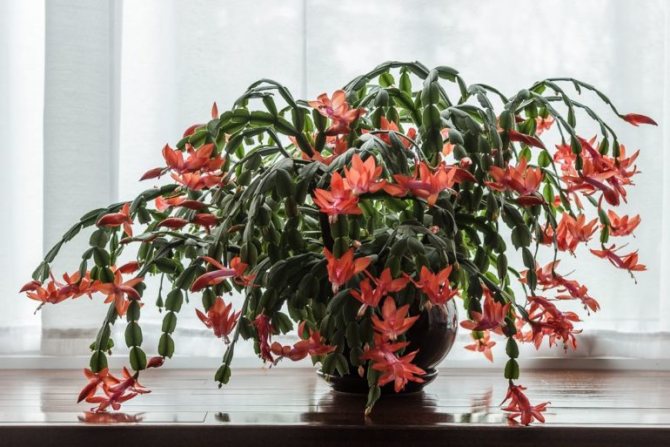

The Decembrist flower usually does not cause much inconvenience to gardeners. But it is impossible to exclude the occurrence of some problematic situations associated with the growth of leaves and stems, as well as flowering. We have already talked about something, something should be said additionally.
Table 1. Problems with the cultivation of zygocactus.
| Problem | The reasons | Solution to the problem |
| The flower withers | The pot is next to a hot radiator, which causes the leaves to wrinkle. Another likely cause is over-watering. | It is necessary to rearrange the pot to a cooler place (however, if you do this during flowering, the flowers will disappear). You should also reduce the intensity of watering, replacing it with abundant spraying. |
| Leaves and buds fall | The main reason is over-watering. | It is necessary to reduce the intensity of watering. After a while, you need to remove the flower from the container, remove the rotten roots and transplant it into new soil. |
| The stems and leaves of the plant turn red | The main reasons: excessive watering, improperly selected top dressing, direct sunlight, drafts. | It is important to exclude all of the listed provoking factors. You should also keep the Decembrist in a cool room, away from drafts and bright sunlight. |
| Plant growth has slowed down | The main reasons: lack of moisture, untimely application of top dressing to the soil, too bright light. | From the beginning of spring until the end of summer, special fertilizers must be applied to the soil. You should also regularly water, spray and wash the leaves and stems with warm, settled water. |
Pests of the Decembrist
- If brownish tubercle spots about 4 mm in size appear on the leaf blades, most likely these are scale insects. They feed on the sap of the plant, the leaves wither and fall off.
- If you notice thin cobwebs between the Decembrist's shoots, the stem is covered with a rusty bloom, and the leaves begin to crumble, then most likely the flower has been struck by a spider mite. These insects are very small, brown, yellow or reddish in color. They appear on plants in rooms with dry air and feed on their sap.
- If you notice whitish lumps that look like flour or cotton between the leaf segments, most likely your pet has been attacked by mealybugs.
In any case, first of all, rinse off the parasites in the bathroom under a stream of warm shower. Remove parasites from the plant as much as possible with a cotton swab dipped in a solution of laundry soap. And then treat with preparations-insecticides such as "Aktellik", "Fitoverm", "Neoron", "Aktara".
Read the instructions on the packaging of the preparations. Treatment alone is not enough to completely eliminate parasites. Repeat the treatment as many times as recommended by the manufacturer. Also, treat the window sill where the affected cactus pot was to prevent insect larvae from remaining on it.
Plant pests and diseases
With proper and regular care, the Decembrist is quite resistant to various diseases and parasites.
Caution! Florist errors in the maintenance of Schlumberger weaken the plant, which can lead to disease or insect damage.
Insects dangerous for the plant
Pests include spider mites, thrips and mealybugs. The affected plant must be quarantined, treated with insecticides and correct errors in content due to which it has weakened.
Infections
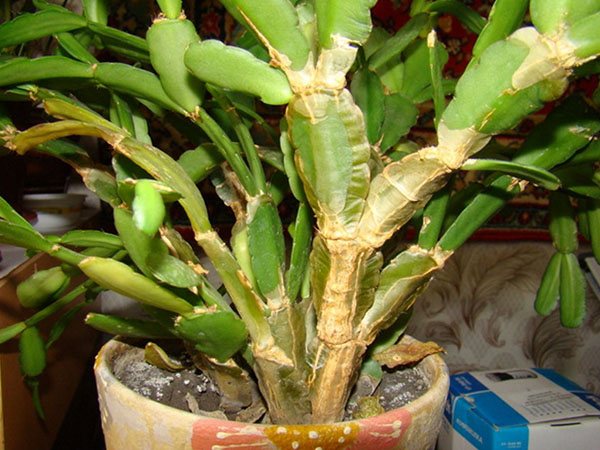

The diseases affecting Schlumberger are of a different nature. Fungal pathogens are dangerous for the plant, the appearance of which causes late blight, rot cladody and fusarium. There is also a bacterial disease - stem base rot.
Among the methods of treatment, it is possible to advise the correction of care regimes, treatment with fungicides and pesticides, cuttings of a cactus in order to save it in case of severe damage.
Homeland of the Schlumberger flower
This blooming joy has moved to us from the rainforests of Brazil. Many people ask, why is he called a Decembrist? Most flower growers answer, but because it blooms in December, but this begs the second question, why in December or in February? Well, all the same, it will be right that nature cannot be fooled, because summer begins in Brazil, and it is winter time that is already coming here. Our pet got used to that season, and now we are pleased with the winter.
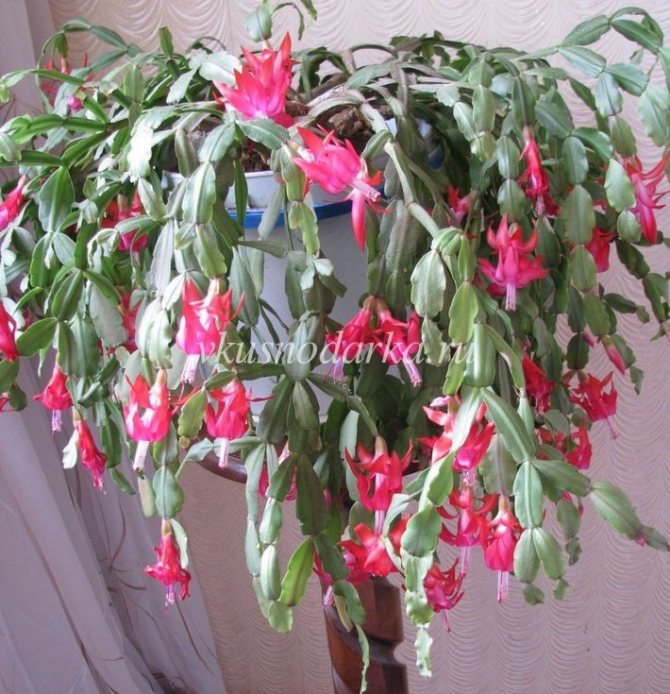

Christmas flower
What does Feng Shui plant mean?
What place to choose to place the Decembrist? A place where, according to the teachings of Feng Shui, he would bring harmony and happiness to the house? But it is worth making a reservation right away - the place is not so important. The main thing is that the Decembrist grows well and feels comfortable on it, and only in this way will he contribute to:
- fill the house and its atmosphere with comfort and peace, a good, positive attitude;
- Schlumberger protects the home itself and the home from negative thoughts and thoughts;
- helps to establish positive and warm, bright relationships in the family;
Important! A flower just like a green healer is necessary in a house in which there are always many people - each person carries his own energy, not always kind and light.
The meaning of a flower in astrology
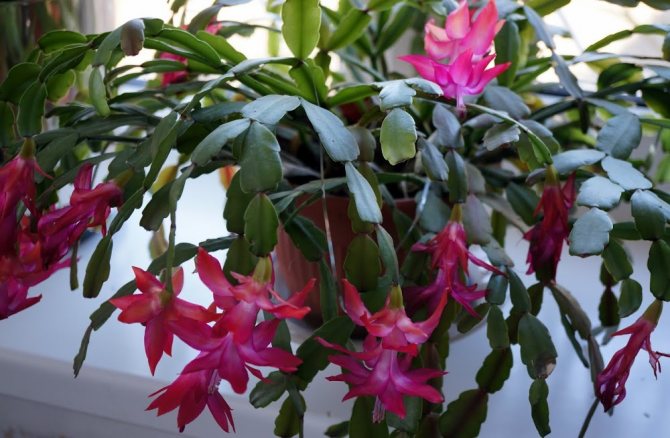

The Decembrist has not only his own superstitions and superstitions prevailing among the people - famous astrologers paid their attention to him and also formed their own beliefs about Schlumberger. Practicing astrologers believe that this plant in the house is capable of absorbing negative energy. He is able to divert evil from home and nullify all kinds of conflicts.
Due to this ability of a green energy healer, it is worth starting in the following cases:
- For spouses who got married not so long ago and are just rubbing against each other - the plant will help smooth out conflicts and achieve mutual understanding;
- Astrologers recommend putting the plant in the children's room - the Decembrist helps to tune the child to a creative mood, to develop hidden talents and powers in him;
- The plant helps the family not to attract unwanted guests with negative thoughts to the house;
- Helps the Decembrist to create an idle and creative atmosphere, to add a touch of joy and fun;
The Decembrist helps to solve many difficult situations, insoluble issues. But the main condition for the implementation of positive signs is that when buying a plant, choose it with your heart, and when giving money for a green doctor, think about the positive.
What is the uniqueness of a tropical plant
An unusual bush in its appearance has a very different name. Schlumberger's flower - this is the name given to him by scientists, Rozhdestvennik and the Decembrist - this is the name given by the people, since it knocks out the buds on Christmas Eve, December - January.
The plant absorbs the energy of home and family, and gives them back processed "information" by its appearance, prompts and warns about future events. If the plant withers, the atmosphere in the house will also be appropriate. But a green bush growing violently indicates peace and tranquility, harmony in the house, at the same moment a withering and dying plant signals negative events in the family.
How can a forest cactus be dangerous: is it poisonous or not?
Zygocactus is one of the most popular flowers in educational and medical settings. It is absolutely non-toxic for adults, children, pets, and the plant is also not capable of causing allergic reactions.
However, German scientists, as a result of a series of studies, came to the conclusion that zygocactus can cause breathing difficulties in asthmaticsif there are several specimens of a flower indoors. Pets that chew on the leaves can cause stomach upset and laryngeal edema.
Answers to popular questions
Florists who grow this plant can face common questions as the flower misses its flowering period or grows poorly.
Why is it growing poorly?
Poor plant growth can be caused by various reasons:
- Poor soil condition;
- Bay after flowering;
- The withering away of the roots;
- A small proportion of watering in the summer.
To correct the situation, you need to get the flower out of the soil, inspect the root system, if it is in order, then you need to select a container according to the size of the root system and offer the flower the appropriate nutrient soil. If there are no roots, for various reasons, the flower needs to be re-rooted.
Why does it fade?
It is necessary to examine the root system, most likely it is lost and the flower does not receive nutrition. The solution to the question is to root the flower again.
How often does it bloom?
Decembrist blooms annually. But this is only if the correct care is organized for him according to the seasons.
Transfer
If the Decembrist does not bloom, you can try to transplant it into a container 2 cm larger than the previous pot. This will make it possible to expand the root area and give nourishment to the leaves so that flower stalks are laid.
The rules for transplanting the Decembrist zygocactus are as follows:
- A drainage layer is laid at the bottom, which makes up a third of the total volume of the pot.
- A layer of prepared soil is poured onto it.
- The plant is removed from the old pot and rearranged into a new one.
Before transplanting, the roots are examined to remove rotten or dry ones. The sections are treated with activated carbon.


Flowering and the reasons for its absence
There are several reasons, why the Decembrist flower does not bloom with good care:
- Little light - the plant is in a dark corner.
- When the buds were laid, the flower was transferred to another place.
- Breeding material was taken during preparation for flowering. Due to stress, the Decembrist stopped the process.
- A sharp change in temperatures. This is harmful for tropical plants.
- The room is too hot and the air is dry. The plant prefers coolness.
- Transplanting into a too large pot - the zygocactus directed all its forces and nutrients to the growth of the roots.
- An unexpected change in conditions, for example, moving to a new apartment with the plant.
- The vegetation and dormancy regime is poorly observed - the plant did not have time to move away from stress.
- There are few nutrients - additional feeding or transplantation into nutrient soil is needed.
Sometimes it is necessary to rejuvenate the plant, since in the old, the lower part of the shoots lignifies and changes color to brown. It does not look aesthetically pleasing, in addition, the plant has difficulties with nutrition. Rejuvenation occurs by separating the upper green plates and transplanting them into new pots.
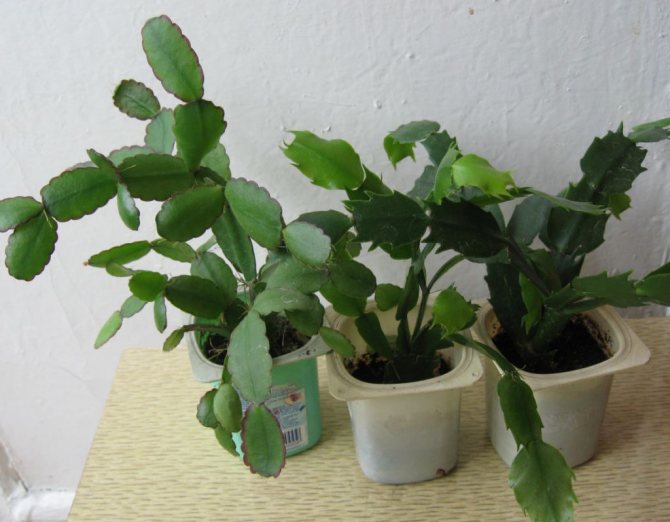

Pruning
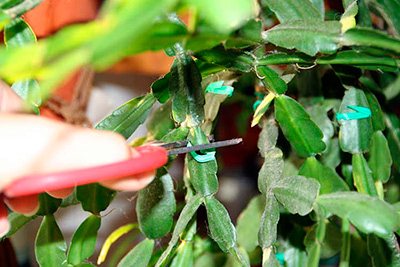

In order for the flower to look beautiful outwardly, it requires pruning, which is carried out annually in the spring.
In early March, each last segment of the plant must be unscrewed clockwise, later two young leaves will appear in this place, and this will give the plant a splendor and compact crown.
Also, flowering occurs only on young leafy cuttings.
Cuttings that have formed after pruning are used for reproduction.
How to reanimate?
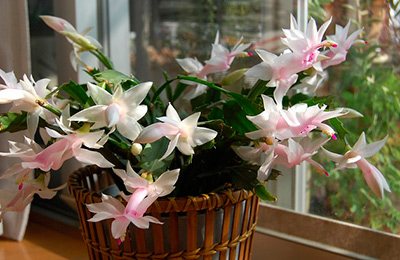

If the flower dies and the cause is not known, the first thing to do is to inspect for pests.
If they are, they are disposed of with chemicals.
If they are not identified, the flower is taken out of the ground and the roots are examined.
Dried roots must be grown again in any convenient way. Decaying roots are cut and treated with ash from deciduous plants.
So that after all the manipulations the flower comes to its senses more easily and adapts, it must be processed with Zircon.
Benefit and harm
In addition to unpretentiousness, the Decembrist is also a very useful plant. Astrologers and feng shui experts recommend putting the Christmas tree in crowded places: schools, gardens, offices.The plant does not require a specific location, the main thing is that it is healthy.
The influence of the plant on people is quite significant:
- it clears the energy in the premises, promotes the establishment of communication and the resolution of conflicts;
- the location of the Decembrist in the psychologist's offices will be very successful - he will contribute to the desire of people to communicate. He can have the same effect on shy, timid people, liberating them;
- the flower helps to identify people with bad intentions - with them, it begins to wither;
- the plant helps young couples to get along with each other, as it can settle conflicts;
- helps children develop spiritually and creatively, fills them with kindness;
- the cactus as a whole is able to extinguish negativity, drive away bad intentions and thoughts;
- a Christmas tree can even direct inveterate egoists on the path of altruism and helping other people;
- it is believed that the Decembrist has healing properties, especially for diseases of the joints and muscles.
The negative qualities of Schlumberger are also noted:
- the plant is popularly called "muzhegon". It is believed that a woman should not start it, otherwise men will not stay in her house, and she risks being left alone;
- it is believed that if a flower is poorly cared for and it starts to hurt, a family member may also get sick.
Dormant period
After abundant long flowering, the plant needs rest. As a rule, this time falls on the end of February and March. Place the pot in a cool or even unheated area. It can be placed on a stand near the window behind a translucent curtain. Reduce the number and intensity of watering gradually. In early April, move the flowerpot to its usual place. Increase the moisture content of the soil and air. Also start feeding.
The Decembrist should have a rest time before flowering and budding. Usually this is the end of September - November. Place the flowerpot in a cooler, shaded area. Reduce watering gradually and stop feeding. When the first buds begin to appear on the jointed shoots, transfer the pot to a bright room with a temperature of +15 ... +20 ° С.
Can I keep at home
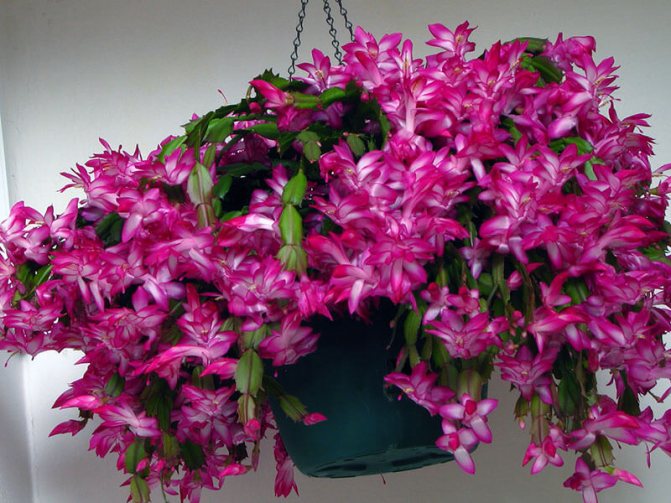

Is it possible to keep the Decembrist at home? The question itself is easy to answer without thinking - it is possible and even necessary. It is Schlumberger who deserves a special place on the windowsill, pleases with its flowering and protection from negativity. And beautiful flowers and a healthy look say that a green doctor is properly looked after. And on cold winter evenings it is so pleasant to watch the beautiful flowers of Schlumberger, fully adopting the spirit and fairy tale of Christmas.

